What comes to your mind when you think of lakes? A body of water thriving with life and visitors, both humans and birds alike or a place that evokes nostalgia? How many lakes do you know about in the city or area where you live?
Lakes and their importance:
The word ‘lake’ originated from the Latin word ‘lacus’ and is a large body of water within a body of land. Lakes do not flow like rivers but have many rivers flowing into them.
Lakes not just offer environmental benefits but also influence the quality of life and strengthen the economy. Lakes can ease the impact of floods and droughts by storing and releasing large amounts of water.
Lakes also play a significant role in replenishing groundwater, ensuring a perennial water supply to the surrounding areas. Over time, lakes have evolved to become a hub of recreation, life, and activity rather than a mere water body. Today, many lakes across the world are a site where flora and fauna flourish! India is home to many picturesque lakes, and Bengaluru itself is not far behind! The city is home to many lakes and at one point had nearly 1000 lakes!
History:
Most of Bengaluru’s lakes are irrigation tanks that were built many centuries ago. In the 16th century, Kempe Gowda built tanks and irrigation wells that were interlinked through a cascade system, ensuring no water was wasted. Kempe Gowda’s vision of building a city from scratch brought Bengaluru to life. He had a vision of creating a perennial supply of water in the city. Many tanks were built, and numerous canals were introduced to connect them, leading to some pristine lakes in Bengaluru.
Many rulers and kingdoms like Marathas, Hoysalas, Wodeyars have all been patrons of lakes and tanks. While the rulers ensured that the tanks were maintained, community and village elders decided on water usage. There were people who distributed water to a village or community tank. It was the community that played an active role in maintaining and cleaning the water bodies. At the same time, farmers and fishermen used the lakes for economic purposes. Slowly, lakes even evolved into a religious and cultural hub, with people celebrating festivities around it. By developing into a centre for religious activities, lakes also offered ecological benefits as idols made out of silt and clay would be immersed in the lakes and tanks. This immersion would help desilt tanks and move silt from smaller to larger ones.
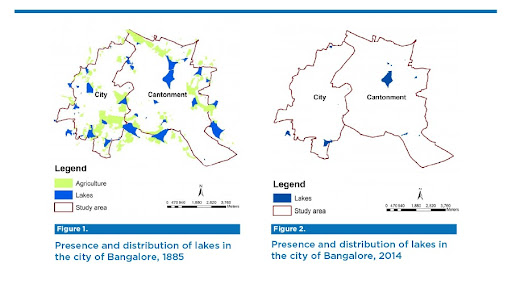
According to the Environment and Society Portal, Bengaluru had an abundance of lakes in 1885, which aided in agriculture. The increasing population led to encroachment, bringing down the number of lakes in the city to a minimum by 2014.
Lakes in Bengaluru:
Kere (ಕೆರೆ) stands for ‘lake’ in Kannada. Bengaluru does not have a perennial river running nearby, and the water dependency lies on River Cauvery, which is also very far. Keres in Bengaluru are an integral part of the culture, economy and history. Wetlands like kere are productive and nurture biodiverse ecosystems within themselves.
Bengaluru also has many smaller water bodies – gokattes (defined as water bodies of between 1 and 3 acres) and kuntes (defined as water bodies less than 1 acre) – which have been around for centuries. Kattes and kuntes are important for water security, biodiversity and flood prevention.
In the 1960s, the number of tanks and lakes in Bengaluru was around 920. The numbers reduced to less than 580 in 1993. Till almost 1895, many lakes in Bengaluru were a source of unfiltered water. According to a report by Environmental Management and Policy Research Institute, 57.5% of gokattes and 75% of kuntes of Bengaluru have disappeared.
Of the several freshwater lakes and water tanks, the largest are Bellandur lake, Madiwala lake, Hebbal lake, Ulsoor lake and Sankey tank.
According to a study by Energy and Wetland Research Group, Centre for Ecological Sciences, Indian Institute of Science, the 262 wetlands that existed in Bengaluru in 1962 declined to 58% by 2007. With the city’s built-up area shooting up by 466% between 1973-2007, the 51 active wetlands in 1973 dipped to 17 in 2007. During the same time, the number of lakes in Bengaluru came down to 93 from 159.

The map dating back to the 1930s indicates the boundaries of the city (shown in thick orange and yellow lines). The orange represents the Cantonment part of Bengaluru, and yellow, the civilian part. The map also indicates numerous lakes in the city.
Some of the surviving lakes in the city are:
- Ulsoor Lake: It is located in Halasuru, on the eastern side of Bengaluru. Spanning over 126 acres, it is regarded as one of the biggest lakes in the city. Even though the lake is dated to Kempe Gowda’s time, the present lake was created by Sir Lewin Bentham Bowring, the then Commissioner of Bengaluru.
- Bellandur Lake: It is one of the largest lakes in the city and is believed to be originally a tributary of the Dakshina Pinakini river. The lake itself was constructed during the reign of the Western Ganga Dynasty, who ruled between the 4-5th century to the 10th century. Today, it is known for its pollution. This lake is a part of the drainage system in Bellandur, which drains the southern and south-eastern parts of the city. Water from this lake flows further east to the Varthur Lake, from where it flows down the plateau and eventually into the Pinakini river basin. The Bellandur tank today is famous for industrial effluents and booming white foam.
- Sankey Tank: Sankey Tank is a manmade tank situated in the western suburbs of Bengaluru. It was constructed by Col. Richard Hieram Sankey in 1882, to meet the water supply demands of the city. It was linked to the Miller’s tank and Dharmambudhi tank and was built as a safeguard against water shortages. The tank was also known as Gandhadhakoti Kere, as the Government Sandalwood Depot used to be located near the lake.
- Madiwala Lake: It is one of the biggest and oldest lakes in the city, and is believed to have been built by the Cholas overnight. The lake is visited by spot-billed pelicans during the winters. It is also home to many migratory birds.
- Lalbagh Lake: The lake is located in the Lalbagh Botanical Gardens, which was established in the year 1760 by Hyder Ali. The credit for the development of this natural lake and its surrounding areas goes to the then Superintendent of Lalbagh, James Cameron, who commissioned the lake in 1890 to provide water to the botanical garden. Under his orders, the bund was built and ornamental steps leading to the lake were constructed. He also set up a waste weir to the lake. One of the most outstanding features of Lalbagh Lake is its breathtaking surroundings. The Lalbagh Botanical Gardens is spread over an area of 240 acres and has more than 1850 species of plants and trees and a large variety of birds and aquatic species.
- Hebbal Lake: It is located in Hebbal, northern Bengaluru, at the mouth of NH 7. It is one of the three lakes created by Kempe Gowda, in 1537. Like most lakes or tanks in Bengaluru, it was formed through the construction of bunds. Some of the birds found at this lake are the spot-billed pelican, Eurasian spoonbill, Indian spot-billed duck, sandpipers, purple herons and grey herons.
- Agara Lake: It is a 98-acre natural lake located between the Koramangala and HSR Layout in South Bangalore, that dates back to the 8th century. The lake is filled by the water of Madiwala lake, through the Raja Kaluve (natural or man-made stream that connects lakes to each other). Surplus water is drained to Bellandur Lake.
- Varthur Lake: This is the second largest lake in the city, spread over 180.40 hectares. Varthur Lake is an artificial lake that has played an important role in maintaining water resources for irrigation since its construction during the Ganga Empire over 1,000 years ago.
- Vengaihnakere Lake: Located at KR Puram, the Vengaihnakere Lake is developed by the Lake Development Authority. It is also known as KR Puram Lake or Fantasy Lagoon and is spread across 40 acres of land.
- Jaraganahalli Lake: It is also known as Yelachenahalli Lake. The lake is believed to have been around for 100 years.
- Vibhutipura Lake: During Tipu Sultan’s time a network of lakes with interconnected channels were built to ensure a perennial supply of water. The tanks and lakes were interconnected in such a way to ensure that no lake gets flooded and all had some water. The Vibhutipura Lake was built to be a part of the network of lakes.
- Nagavara Lake: Located on the Outer Ring Road, Nagavara Lake is a part of Lumbini Gardens, which serves as an attraction for families in the city.
- Kengeri Lake: Developed by the state forest department in 1995, the Kengeri Lake is located on Mysore Road and is also known as Doddakere.
- Kempambudhi Lake: Kempambudhi Kere is situated behind Jinke Park, Chamrajpet, Bengaluru and is spread across 47 acres. Kempe Gowda I (1513-1569), the Vijayanagara kingdom chieftain who is credited with the founding of Bengaluru, built the lake for his family deity Kempamma in the 16th century. This lake is believed to be the first lake in the Vrishabhavathi stream series. The lake was once the life of Old Bengaluru (Chamarajapete and Basavanagudi) from where the city flourished.
- Hesaraghatta Lake: Located on the northwest of Bengaluru, the Hesaraghatta Lake is a manmade reservoir built in 1894, across the Arkavathy river. Hesaraghatta Lake was conceived by Sir K. Seshadri Iyer, the Dewan of erstwhile Mysore state and the M. C. Hutchins, the chief engineer of Mysuru, to meet the drinking water requirements of the city.
- Puttenahalli Lake: Puttenahalli Lake is a small, restored freshwater lake in southern Bengaluru. The primary water sources are rain and surface water diverted to the lake through channels. The lake is currently maintained by Puttenahalli Neighbourhood Lake Improvement Trust (PNLIT). The lake was on the brink of extinction, but due to the efforts of PNLIT, it is now a haven for bird-watchers and is on its way to being completely restored.
- Yediyur Lake: The Yediyur Lake is located near Kanakapura Road and is believed to have been in existence since the rule of the Hoysala Kings. At present, the Bengaluru City Corporation, under the Kere Siri Yojana has developed a park around the lake, making it a tourist attraction in the city.
According to the Institute of Social and Economic Change, rapid urbanization in Bengaluru has resulted in housing colonies being expanded in an unplanned manner, causing severe damage to the environment.

Most of the lakes in Bengaluru have vanished due to encroachment and construction activity for urban infrastructure expansion. The city, which once had 280-285 lakes, has:
- Seven untraceable lakes.
- Seven lakes have been reduced to small pools of water.
- Eighteen lakes have been unauthorisedly encroached by slums and private parties.
- Fourteen lakes have dried up and are leased out by the Government.
- Forty-two lakes have been converted to residential layouts, playgrounds, stadiums, industries, government buildings and bus stands. Scores of private projects, apartments, independent houses and commercial complexes now stand on some erstwhile lakes.
- Twenty-eight lakes have been used by the Bangalore Development Authority to distribute sites and build extensions for residential areas. The remaining lakes are in a fairly advanced state of deterioration.
This is the current situation of some of the lakes and tanks in Bengaluru:
- Sampangi Tank: The Sampangi Tank/Lake where today’s Kanteerava Stadium stands in Bengaluru, was an important source of drinking water until the late 1800s. In addition to being a source of drinking water, the lake also supported many traditional horticulturists called the Vanniyakula Kshatriyas. This community came into the city around the early 16th century, and since then, have celebrated the city’s oldest festival – the Karaga – whose rituals revolve around important water-bodies across the city. Rituals performed at the Sampangi Lake mark the beginning of these annual festivities, and it is only because of this that a tiny vestige of the lake remains. Besides horticulturists, the lake supported various traditional livelihoods such as fishing, brick making, clothes laundering, and pastoralism. To celebrate the sacredness of lake waters, a second annual festival called Gange Pooja was held. The Kanteerava Stadium, constructed on the bed of the Sampangi Lake, was opened in 1946.
- Dharmambudhi Kere: The Dharmambudhi Kere was one among the several tanks excavated by Kempe Gowda I when he laid the foundation of Bangalore in 1537. This tank was once the chief source from which the inhabitants of Bengaluru derived their supply of drinking water. From this tank water was led to the streets through channels and taken out by the people. In 1864 a road was formed all around the Dharmambudhi tank, the bed cleared and its storage capacity increased. Lack of maintenance in the subsequent years led to the shrinking of water in the Dharmambudhi tank and during 1892-93 when monsoons failed, Bengaluru witnessed a water shortage. With the water supply completely drying up, the Dharmambudhi lake bed was used for holding public meetings. Over the years, the Dharmambudhi Kere got converted into the present-day Majestic Bus Stand which houses the BMTC and KSRTC buses.
- A few other lakes that have been converted:
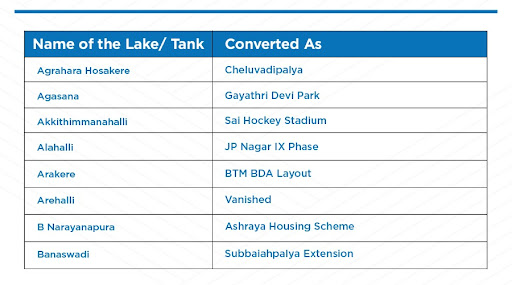
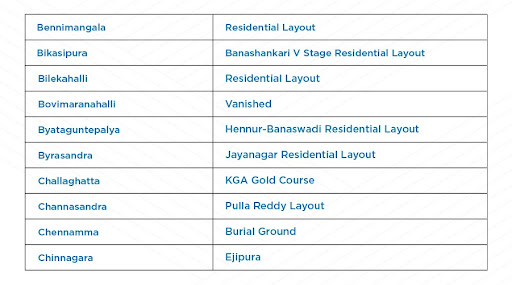
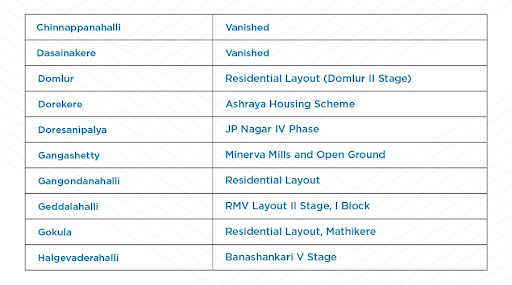
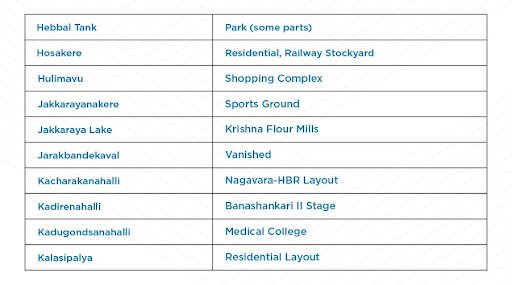

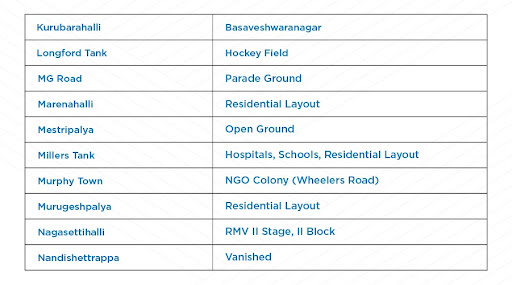



According to a report by the National Environmental Engineering Research Institute (NEERI), at least 16 lakes are fully encroached and are unlikely to be restored. They are Ancheramanakere, Belakahalli, Bovimaranahalli, Byatagunte Palya, Chikkalsandra, Doresanipalya Geddalahalli, Gundopanth, Ittmadu, Karisandra, Konena Agrahara, Lingarajapura Sanigoruvahalli, Nandi Shettappa, Shivanahalli and Vijanapur.
The Indian Institute of Science’s report also finds that of the 360 recognized slums in Bengaluru, 30% have underground sewage systems, while a majority of them have wastewater discharged through stormwater drains that end up in lakes. Even wastewater from apartments gets discharged into the lakes.
Indiscriminate drilling of borewells is believed to be another cause leading to the disappearance of lakes. Bengaluru has more than 1,25,000 borewells, and the water level in the city has plunged below 400 feet.
Lakes, ecosystem and encroachment:
The lakes in Bengaluru nurture a wide variety of flora and fauna. With encroachments happening at a rapid scale, there is an imbalance created in the lakes and ecosystem, ultimately harming the city’s population.
- Many lakes in Bengaluru are green as they are blanketed by microscopic plants containing chlorophyll, called algae. They help fix the carbon and generate biomass and are vital for the lakes and the ecosystem. Excess algae, especially the harmful types, can be detrimental to the lake, indicating pollution and high quantities of nitrogen and phosphorus. An overgrowth of algae can cause ‘dead zones’ in the lakes, making it impossible for aquatic life to survive, owing to insufficient oxygen. In Bengaluru, the discharge of industrial waste and untreated sewage has resulted in the rapid increase of the algae population, resulting in the lakes being polluted, discoloured and clogged, giving out a certain odour.
- Effluent is wastewater that contains high amounts of toxins, typically from factories, industries or sewer plants. When effluents are discharged into freshwaters like lakes, it affects the water and reduces the oxygen content, making it unusable. Even the soil fed by this toxic water gets affected. The toxic water and soil end up becoming harmful for plants and animals that come into its contact. Effluents are one of the significant reasons for the frothing of lakes. Bengaluru’s Bellandur lake is infamous for the froth due to effluents, non-biodegradable detergents and other toxins released into the lake.
- Bengaluru has been experiencing climate changeover the past few years, and this is partly due to a phenomenon called Urban Heat Island. With the city expanding daily, natural spaces like green covers, lakes, and wetlands are replaced with dense concrete, glass, and steel structures. This results in the temperatures soaring. Lakes are an essential aspect of a microclimate in an area. They help maintain atmospheric temperatures, reducing the impact of the Urban Heat Island effect.
- The Vrishabhavathiriver flows through the south of Bengaluru. The river was once so pristine that it was used as a source of drinking water. Today, it stands heavily polluted. The river has many lakes draining into it, and thus, untreated sewage flows into it from the lakes. The Vrishabhavathi river eventually winds out in the Arkavathi River, carrying the city’s trash and damaging water supplies downstream.
Agencies working towards Saving the Lakes:
Saving the lakes is of utmost importance in today’s scenario. Here are some agencies working towards the betterment of lakes in Bengaluru:
- The Lake Development Authority (LDA) was constituted as a registered society in 2002 by Karnataka to conserve and protect the lakes in Bengaluru and other neighbouring areas. The LDA keeps an inventory of the wetlands in Karnataka.
- Bruhat Bengaluru Mahanagara Palike (BBMP) works on the development and restoration of lakes.
- The Forest Department is in charge of around 114 lakes in Bengaluru.
- The Bengaluru Development Authority (BDA) has also contributed towards the restoration of lakes in the city.
- The Karnataka State Government also plays a crucial role in the restoration and revival of lakes.
- The Central Government launched the National Lake Conservation Plan in 2001 to conserve and manage polluted lakes.
- The City Municipal Councils of different cities across Karnataka are also responsible for maintaining lakes.
- The public, in general, have also been striving towards the restoration of lakes in the city. They are actively engaged in citizen groups to ensure the betterment of lakes in the city. Citizen groups along with BBMP have successfully restored prominent lakes in the city.
- There are many Non-Governmental Organizations and Environmental Groups in the city working towards the restoration, maintenance and management of lakes in the city.
Effective and sustained involvement of all agencies can make a massive difference in the revival of lakes in Bengaluru. Working together can help restore the lakes to their original state and ensure a better ecosystem!





